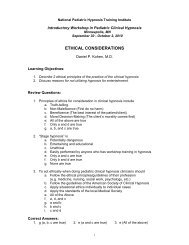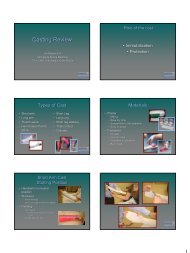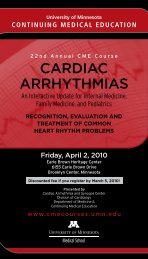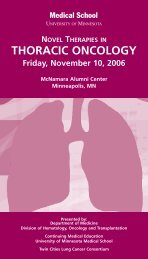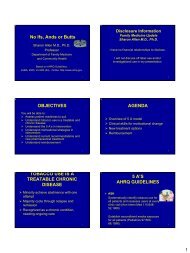Case Studies in Chronic Pain Case Formulation Pain Types by ...
Case Studies in Chronic Pain Case Formulation Pain Types by ...
Case Studies in Chronic Pain Case Formulation Pain Types by ...
Create successful ePaper yourself
Turn your PDF publications into a flip-book with our unique Google optimized e-Paper software.
D.I.R.E. Score: Patient Selection for <strong>Chronic</strong> Opioid Analgesia<br />
For each factor, rate the patient’s score from 1-3 based on the<br />
explanations <strong>in</strong> the right hand column<br />
Score Factor Explanation<br />
Diagnosis<br />
Intractability<br />
Risk<br />
Psychological:<br />
Chemical Health:<br />
Reliability:<br />
Social Support:<br />
1 = Benign chronic condition with m<strong>in</strong>imal objective f<strong>in</strong>d<strong>in</strong>gs or no def<strong>in</strong>ite<br />
medical diagnosis. Examples: fibromyalgia, migra<strong>in</strong>e headaches, nonspecific<br />
back pa<strong>in</strong>.<br />
2 = Slowly progressive condition concordant with moderate pa<strong>in</strong>, or fixed<br />
condition with moderate objective f<strong>in</strong>d<strong>in</strong>gs. Examples: failed back surgery<br />
syndrome, back pa<strong>in</strong> with moderate degenerative changes, neuropathic pa<strong>in</strong>.<br />
3 = Advanced condition concordant with severe pa<strong>in</strong> with objective f<strong>in</strong>d<strong>in</strong>gs.<br />
Examples: severe ischemic vascular disease, advanced neuropathy, severe<br />
sp<strong>in</strong>al stenosis.<br />
1 = Few therapies have been tried and the patient takes a passive role <strong>in</strong><br />
his/her pa<strong>in</strong> management process.<br />
2 = Most customary treatments have been tried but the patient is not fully<br />
engaged <strong>in</strong> the pa<strong>in</strong> management process, or barriers prevent (<strong>in</strong>surance,<br />
transportation, medical illness).<br />
3 = Patient fully engaged <strong>in</strong> a spectrum of appropriate treatments but with<br />
<strong>in</strong>adequate response.<br />
(R= Total of P+C+R+S below)<br />
1 = Serious personality dysfunction or mental illness <strong>in</strong>terfer<strong>in</strong>g with care.<br />
Example: personality disorder, severe affective disorder, significant<br />
personality issues.<br />
2 = Personality or mental health <strong>in</strong>terferes moderately. Example: depression<br />
or anxiety disorder.<br />
3 = Good communication with cl<strong>in</strong>ic. No significant personality dysfunction or<br />
mental illness.<br />
1 = Active or very recent use of illicit drugs, excessive alcohol, or prescription<br />
drug abuse.<br />
2 = Chemical coper (uses medications to cope with stress) or history of CD <strong>in</strong><br />
remission.<br />
3 = No CD history. Not drug-focused or chemically reliant.<br />
1 = History of numerous problems: medication misuse, missed appo<strong>in</strong>tments,<br />
rarely follows through.<br />
2 = Occasional difficulties with compliance, but generally reliable.<br />
3 = Highly reliable patient with meds, appo<strong>in</strong>tments & treatment.<br />
1 = Life <strong>in</strong> chaos. Little family support and few close relationships. Loss of<br />
most normal life roles.<br />
2 = Reduction <strong>in</strong> some relationships and life roles.<br />
3 = Supportive family/close relationships. Involved <strong>in</strong> work or school and no<br />
social isolation.<br />
Efficacy score<br />
1 = Poor function or m<strong>in</strong>imal pa<strong>in</strong> relief despite moderate to high doses.<br />
2 = Moderate benefit with function improved <strong>in</strong> a number of ways (or<br />
<strong>in</strong>sufficient <strong>in</strong>fo- hasn’t tried opioid yet or very low doses or too short of a<br />
trial).<br />
3 = Good improvement <strong>in</strong> pa<strong>in</strong> and function and quality of life with stable<br />
doses over time.<br />
______Total score = D + I + R + E<br />
Score 7-13: Not a suitable candidate for long-term opioid analgesia<br />
Score 14-21: Good candidate for long-term opioid analgesia



